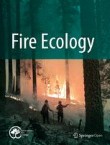Fire Ecology is the official journal of the Association for Fire Ecology.
American Three-Toed Woodpecker Response to Burn Severity and Prey Availability at Multiple Spatial Scales
We evaluated American three-toed woodpecker (Picoides dorsalis) response to spatial heterogeneity of burn severity and prey availability over multiple scales at the 56 000 ha Hayman Fire (2002) located in the Col...
